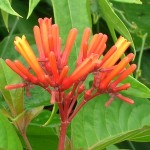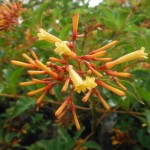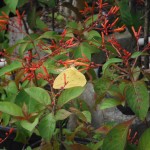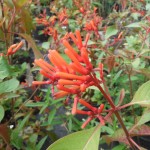Firebush (Hamelia patens)
No less a publication than Southern Living magazine has long recommended our native Firebush, Hamelia patens, to its readership. And it’s no wonder. The species has many endearing qualities.
First, if not foremost, it’s rather cold-tolerant. The Florida Native Plant Society regards it as suitable for planting through Zone 9a, whose northern limit is along a line from the Georgia border at the Atlantic coast to roughly Panama City at the Gulf Coast. However, Firebush can survive in the ground well north of there. It will freeze back in the winter, but regrow from the roots in the spring, particularly if mulched with fallen leaves. North of Zone 9a, the species is quite popular as a fast-growing, colorful annual.
H. patens is also remarkably amenable to various soil types, from the alkaline rockland of southern Florida to the deep acidic soils of the temperate South. It flowers best in full sun, but performs well even in some shade. The species is reasonably drought-tolerant, but can handle plenty of water, so long as good drainage is guaranteed. Once established, maintenance is quite easy; cutting it back periodically will promote compactness and encourage blooming. And it doesn’t even require much fertilizer!
Firebush has a huge native range, from north central Florida and Bermuda in the north through the Caribbean, Mexico, Central America, and into Paraguay in the south. In southern Florida it is a semi-woody evergreen shrub or small tree that reaches about 12 ft. high. Its leaves are oval to elliptical, up to 6 in. long, featuring reddish veins and leafstems. It produces clusters of ¾-in. red-orange or scarlet tubular flowers throughout the year. Its berries are also attractive, developing through a range of colors from green to yellow to red to glossy black.
In the ground, Hamelia can be used as a solid hedge or can be mixed with other materials, but it can also be featured to great advantage as a stand-alone specimen. It is quite popular in hummingbird and butterfly gardens. In colder locations that experience a distinct winter, Firebush makes an outstanding container plant that can be brought indoors and kept in a bright location until the return of warm weather.
H. patens also possesses some medicinal qualities. Indigenous peoples found that stem and leaf extracts could be used to ameliorate dermatological problems, including sores, rashes and fungus. Those ethnobotanical applications have been bolstered by modern studies that isolated chemicals possessing antibacterial and antifungal properties. Other Firebush extracts have been shown in animal studies to contain hypothermic, analgesic and diuretic qualities.
H. patens is available at the nursery in 3-gal. containers.





